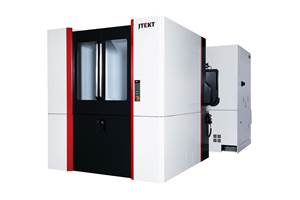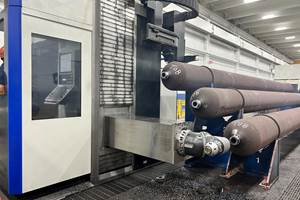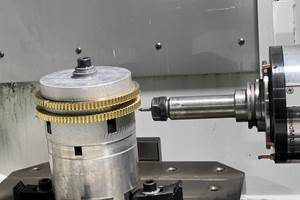HMC Helps Optimize Engine Performance And Reduce Time To Track
The precision craftsmanship that goes into building an engine will usually separate the winners from the also-rans at NASCAR's highest levels. This certainly applies to cylinder head development, because so much power from the engine is produced in and around these chunks of aluminum. Cylinder heads are horsepower, and horsepower delivers speed. When an engine builder gets a new cylinder head in at the shop, there's a lot of work that needs to be done to get it into racing condition.
The precision craftsmanship that goes into building an engine will usually separate the winners from the also-rans at NASCAR's highest levels.
This certainly applies to cylinder head development, because so much power from the engine is produced in and around these chunks of aluminum. Cylinder heads are horsepower, and horsepower delivers speed. When an engine builder gets a new cylinder head in at the shop, there's a lot of work that needs to be done to get it into racing condition.
Specialists perform extensive work and put a final finish on cylinder heads. NASCAR mandates prohibit some of the work that can be done to a pair of heads, but within certain basic parameters, the teams are allowed a fair amount of latitude to do some tweaking.
Team Sabco (Mooresville, North Carolina) used to use an outside vendor to do this work. Then it decided to try to do the work in-house.
Team Sabco, which is owned by Felix Sabates and includes drivers Sterling Marlin (No. 40 Coors Light Chevrolet) and Joe Nemechek (No. 42 BellSouth Chevrolet), purchased a Makino A77 horizontal machining center from Makino (Mason, Ohio). The A77 features five-axis simultaneous machining, where all axes move in concert. This produces a smoother contour and finished part.
Sabco primarily machines cylinder heads on the Makino A77. With it, Sabco has the ability to design its own flow model and machine the combustion chamber contours of the cylinder head with precise definition. This translates into gains in horsepower. The key here is airflow, and airflow determines the horsepower output of an engine.
As teams seek better ways to improve horsepower, torque and fuel efficiency, they constantly test, make a change and so on. Having the A77 in-house has substantially reduced "time-to-track" for Sabco.
"We're holding much better tolerances and getting a more accurate job than we were from our vendors," says Keith Simmons, Sabco chief engine builder. "We saw an eight to 12 horsepower gain right off the bat."
With outside vendors, it often took weeks to get cylinder heads, and Sabco never knew whose hands a proprietary design would end up in. "Now we come up with our own cylinder head flow model, and if our guys find something they want to improve, we throw a development head on the Makino, make a change, put it on an engine, run it on the dynamometer and see the results," says John Erickson, vice-president of race operations. "If it looks like the way to go, we'll digitize the heads, program the Makino, machine a pair and have them in one of the cars for the next race."
Another variable that plays into the time-to-track equation is finishing. The finishes of heads coming off the Makino are very smooth. "You could run them right off the machine, but we do a quick sand roll to make sure no carbon will build up," says Billy Ennis, Sabco CNC operator. "We've cut our finishing time dramatically. Now it's a very simple operation that takes only about 20 minutes."
By reducing two weeks plus to eight hours or less, Sabco not only reduces time-to-track, but can now tweak finished part contours. In addition, the ability to duplicate port-to-port and head-to-head allows Sabco to continually raise its minimum standard of performance.
"The Makino machine is reliable, accurate and most importantly repeatable," adds Mr. Ennis. "If we want to duplicate a pair of heads that are performing favorably, we can duplicate them in eight hours and have them ready for both cars."
The A77 possesses machining accuracy and repeatability in the 40-millionths to 80-millionths-of-an-inch range. "We are able to repeat from one head to another set of heads," says Mr. Sabates. "As we improve our cylinder heads to get more horsepower we will be able to duplicate our work. That is the crucial component of our engine development program that we were missing before."
"With our own design, we can change it, we can improve it and keep that information proprietary," says Mr. Ennis.
Consistency is important to Mr. Erickson. "We've standardized our cars. We want all three to be consistent, so when our crew chiefs sit down and compare notes they are correlating apples to apples. The more consistent we can make these cars the better we should be able to pinpoint and solve problems encountered at the track."
Sabco intends to also use the A77 to machine engine blocks, intake manifolds, piston domes, rear end housings and more. It even plans to do some of the more intricate molds for the carbon fiber shop.
"Once we start making more of our own parts in-house, the quality and the craftsmanship will be a lot better," says Tony Glover, Sabco team manager. "And we'll be getting better cars on the race track. The components that we buy now have decent accuracies and tolerances, but nowhere near what we'll be getting off the Makino."
Related Content
Volumetric Accuracy Is Key to Machining James Webb Telescope
To meet the extreme tolerance of the telescope’s beryllium mirrors, the manufacturer had to rely on stable horizontal machining centers with a high degree of consistency volumetric accuracy.
Read MoreJTEKT Launches New Series of HMCs
The new FH5000 series machines include a 500-mm table capable of handling 1,000-kg loads.
Read MoreLarge-Format Machining Simplifies Tube Manufacturing
Downtime is the enemy of efficient manufacturing — a problem FIBA Technologies has addressed through purchasing a Soraluce FLP 14000.
Read MoreFour-Axis Horizontal Machining Doubles Shop’s Productivity
Horizontal four-axis machining enabled McKenzie CNC to cut operations and cycle times for its high-mix, high-repeat work — more than doubling its throughput.
Read MoreRead Next
3 Mistakes That Cause CNC Programs to Fail
Despite enhancements to manufacturing technology, there are still issues today that can cause programs to fail. These failures can cause lost time, scrapped parts, damaged machines and even injured operators.
Read MoreThe Cut Scene: The Finer Details of Large-Format Machining
Small details and features can have an outsized impact on large parts, such as Barbco’s collapsible utility drill head.
Read More







.jpg;maxWidth=300;quality=90)

















